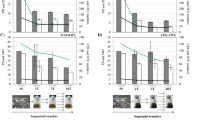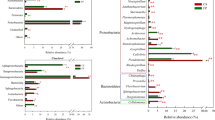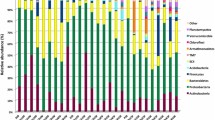Abstract
To develop a targeted metagenomics approach for the analysis of novel multispecies microbial consortia involved in the bioconversion of lignocellulose and furanic compounds, we applied replicated sequential batch aerobic enrichment cultures with either pretreated or untreated wheat straw as the sources of carbon and energy. After each transfer, exponential growth of bacteria was detected using microscopic cell counts, indicating that the substrate was being utilized. In batch, the final bacterial abundances increased from an estimated 5 to 8.7–9.5 log 16S rRNA gene copy numbers/ml. The abundances of fungal propagules showed greater variation, i.e., between 5.4 and 8.0 log ITS1 copies/ml. Denaturing gradient gel electrophoresis analyses showed that the bacterial consortia in both treatments reached approximate structural stability after six transfers. Moreover, the structures of the fungal communities were strongly influenced by substrate treatment. A total of 124 bacterial strains were isolated from the two types of enrichment cultures. The most abundant strains were affiliated with the genera Raoultella/Klebsiella, Kluyvera, Citrobacter, Enterobacter, Pseudomonas, Acinetobacter, Flavobacterium and Arthrobacter. Totals of 43 and 11 strains obtained from the untreated and pretreated substrates, respectively, showed (hemi)cellulolytic activity (CMC-ase and xylanase), whereas 96 strains were capable of growth in 7.5 mM 5-hydroxymethylfurfural. About 50 % of the latter showed extracellular oxidoreductase activity as detected by a novel iodide oxidation method. Also, (hemi)cellulolytic fungal strains related to Coniochaeta, Plectosphaerella and Penicillium were isolated. One Trichosporon strain was isolated from pretreated wheat straw. The two novel bacterial–fungal consortia are starting points for lignocellulose degradation applications.






Similar content being viewed by others
References
Amachi S, Muramatsu Y, Akiyama Y, Miyazaki K, Yoshiki S, Hanada S, Kamagata Y, Ban-nai T, Shinoyama H, Fujii T (2005) Isolation of iodide-oxidizing bacteria from iodide-rich natural gas brines and seawaters. Microb Ecol 49(4):547–557. doi:10.1007/s00248-004-0056-0
Andreote FD, Azevedo JL, Araujo WL (2009) Assessing the diversity of bacterial communities associated with plants. Braz J Microbiol 40:417–432
Aylward FO, Burnum KE, Scott JJ, Suen G, Tringe SG, Adams SM, Barry KW, Nicora CD, Piehowski PD, Purvine SO, Starrett GJ, Goodwin LA, Smith RD, Lipton MS, Currie CR (2012) Metagenomic and metaproteomic insights into bacterial communities in leaf-cutter ant fungus gardens. ISME J 6(9):1688–1701. doi:10.1038/ismej.2012.10
Chandel AK, Singh OV (2011) Weedy lignocellulosic feedstock and microbial metabolic engineering: advancing the generation of ‘Biofuel’. Appl Microbiol Biotechnol 89(5):1289–1303. doi:10.1007/s00253-010-3057-6
Chandra R, Abhishek A, Sankhwar M (2011) Bacterial decolorization and detoxification of black liquor from rayon grade pulp manufacturing paper industry and detection of their metabolic products. Bioresour Technol 102(11):6429–6236. doi:10.1016/j.biortech.2011.03.048
Chen X, Li Z, Zhang X, Hu F, Ryu DD, Bao J (2009) Screening of oleaginous yeast strains tolerant to lignocellulose degradation compounds. Appl Biochem Biotechnol 159(3):591–604. doi:10.1007/s12010-008-8491-x
Cheng JR, Zhu MJ (2012) A novel co-culture strategy for lignocellulosic bioenergy production: a systematic review. Int J Mod Biol Med 1(3):166–193
DeAngelis KM, Allgaier M, Chavarria Y, Fortney JL, Hugenholtz P, Simmons B, Sublette K, Silver WL, Hazen TC (2011a) Characterization of trapped lignin-degrading microbes in tropical forest soil. PLoS One 6(4):e19306. doi:10.1371/journal.pone.0019306
DeAngelis KM, D'Haeseleer P, Chivian D, Fortney JL, Khudyakov J, Simmons B, Woo H, Arkin AP, Davenport KW, Goodwin L, Chen A, Ivanova N, Kyrpides NC, Mavromatis K, Woyke T, Hazen TC (2011b) Complete genome sequence of “Enterobacter lignolyticus” SCF1. Stand Genomic Sci 5(1):69–85. doi:10.4056/sigs.2104875
Dice LR (1945) Measures of the amount of ecologic association between species. Ecology 26(3):297–302
Drancourt M, Bollet C, Carta A, Rousselier P (2001) Phylogenetic analyses of Klebsiella species delineate Klebsiella and Raoultella gen. nov., with description of Raoultella ornithinolytica comb. nov., Raoultella terrigena comb. nov. and Raoultella planticola comb. nov. Int J Syst Evol Microbiol 51(Pt 3):925–932. doi:10.1099/00207713-51-3-925
Eichorst SA, Kuske CR (2012) Identification of cellulose-responsive bacterial and fungal communities in geographically and edaphically different soils by using stable isotope probing. Appl Environ Microbiol 78(7):2316–2327. doi:10.1128/AEM.07313-11
Ekkers DM, Cretoiu MS, Kielak AM, van Elsas JD (2012) The great screen anomaly—a new frontier in product discovery through functional metagenomics. Appl Microbiol Biotechnol 93(3):1005–1020. doi:10.1007/s00253-011-3804-3
Gladden JM, Allgaier M, Miller CS, Hazen TC, VanderGheynst JS, Hugenholtz P, Simmons BA, Singer SW (2011) Glycoside hydrolase activities of thermophilic bacterial consortia adapted to switchgrass. Appl Environ Microbiol 77(16):5804–5812. doi:10.1128/AEM.00032-11
Hasunuma T, Okazaki F, Okai N, Hara KY, Ishii J, Kondo A (2013) A review of enzymes and microbes for lignocellulosic biorefinery and the possibility of their application to consolidated bioprocessing technology. Bioresour Technol 135:513–522. doi:10.1016/j.biortech.2012.10.047
Ho KL, Lee DJ, Su A, Chang JS (2012) Biohydrogen from cellulosic feedstock: dilution-to-stimulation approach. Int J Hydrogen Energy 37(20):15582–15587. doi:10.1016/j.ijhydene.2012.01.093
Hui W, Jiajia L, Yucai L, Peng G, Xiaofen W, Kazuhiro M, Zongjun C (2013) Bioconversion of un-pretreated lignocellulosic materials by a microbial consortium XDC-2. Bioresour Technol 136:481–487. doi:10.1016/j.biortech.2013.03.015
Ji XJ, Huang H, Ouyang PK (2011) Microbial 2,3-butanediol production: a state-of-the-art review. Biotechnol Adv 29(3):351–364. doi:10.1016/j.biotechadv.2011.01.007
Kanokratana P, Mhuantong W, Laothanachareon T, Tangphatsornruang S, Eurwilaichitr L, Pootanakit K, Champreda V (2013) Phylogenetic analysis and metabolic potential of microbial communities in an industrial bagasse collection site. Microb Ecol. doi:10.1007/s00248-013-0209-0
Karigar CS, Rao SS (2011) Role of microbial enzymes in the bioremediation of pollutants: a review. Enzyme Res 2011:805187. doi:10.4061/2011/805187
Kasana RC, Salwan R, Dhar H, Dutt S, Gulati A (2008) A rapid and easy method for the detection of microbial cellulases on agar plates using gram's iodine. Curr Microbiol 57(5):503–507. doi:10.1007/s00284-008-9276-8
Kim SO, Merchant K, Nudelman R, Beyer WF Jr, Keng T, DeAngelo J, Hausladen A, Stamler JS (2002) OxyR: a molecular code for redox-related signaling. Cell 109(3):383–96
Koopman F, Wierckx N, de Winde JH, Ruijssenaars HJ (2010a) Identification and characterization of the furfural and 5-(hydroxymethyl)furfural degradation pathways of Cupriavidus basilensis HMF14. Proc Natl Acad Sci U S A 107(11):4919–4924. doi:10.1073/pnas.0913039107
Koopman F, Wierckx N, de Winde JH, Ruijssenaars HJ (2010b) Efficient whole-cell biotransformation of 5-(hydroxymethyl)furfural into FDCA, 2,5-furandicarboxylic acid. Bioresour Technol 101(16):6291–6296. doi:10.1016/j.biortech.2010.03.050
Lee DJ, Show KY, Wang A (2013) Unconventional approaches to isolation and enrichment of functional microbial consortium—a review. Bioresour Technol 136:697–706. doi:10.1016/j.biortech.2013.02.075
Li H, Xu X, Chen H, Zhang Y, Xu J, Wang J, Lu X (2013) Molecular analyses of the functional microbial community in composting by PCR-DGGE targeting the genes of the β-glucosidase. Bioresour Technol 134:51–58. doi:10.1016/j.biortech.2013.01.077
Li SH, Lin Q, Li XR, Xu H, Yang YX, Qiao DR, Cao Y (2012) Biodiversity of the oleaginous microorganisms in Tibetan Plateau. Braz J Microbiol 43(2):627–634
Liu Z, Gao Y, Chen J, Imanaka T, Bao J, Hua Q (2013) Analysis of metabolic fluxes for better understanding of mechanisms related to lipid accumulation in oleaginous yeast Trichosporon cutaneum. Bioresour Technol 130:144–51. doi:10.1016/j.biortech.2012.12.072
López MJ, Nichols NN, Dien BS, Moreno J, Bothast RJ (2004) Isolation of microorganisms for biological detoxification of lignocellulosic hydrolysates. Appl Microbiol Biotechnol 64(1):125–31
López MJ, Vargas-Garcia MC, Suarez-Estrella F, Nichols NN, Dien BS, Moreno J (2007) Lignocellulose-degrading enzymes produced by the ascomycete Coniochaeta ligniaria and related species: application for a lignocellulosic substrate treatment. Enzyme Microb Technol 40(4):794–800. doi:10.1016/j.enzmictec.2006.06.012
Ma A, Zhuang X, Wu J, Cui M, Lv D, Liu C, Zhuang G (2013) Ascomycota members dominate fungal communities during straw residue decomposition in arable soil. PLoS ONE 8(6):e66146. doi:10.1371/journal.pone.0066146
McBride MJ, Xie G, Martens EC, Lapidus A, Henrissat B, Rhodes RG, Goltsman E, Wang W, Xu J, Hunnicutt DW, Staroscik AM, Hoover TR, Cheng YQ, Stein JL (2009) Novel features of the polysaccharide-digesting gliding bacterium Flavobacterium johnsoniae as revealed by genome sequence analysis. Appl Environ Microbiol 75(21):6864–6875. doi:10.1128/AEM.01495-09
Milenković MC, Stanisavljev DR (2011) The kinetics of iodide oxidation by hydrogen peroxide in acid solution. Russ J Phys Ch 85(13):2279–2282. doi:10.1134/S0036024411130140
Nikolopoulos N, Isemin R, Atsonios K, Kourkoumpas D, Kuzmin S, Mikhalev A, Nikolopoulos A, Agraniotis M, Grammelis P, Kakaras EM (2013) Modeling of wheat straw torrefaction as a preliminary tool for process design. Waste Biomass Valors 4(3):409–420. doi:10.1007/s12649-013-9198-y
Pereyra LP, Hiibel SR, Prieto Riquelme MV, Reardon KF, Pruden A (2010) Detection and quantification of functional genes of cellulose-degrading, fermentative, and sulfate-reducing bacteria and methanogenic Archaea. Appl Environ Microbiol 76(7):2192–202. doi:10.1128/AEM.01285-09
Pereira e Silva MC, Dias AC, van Elsas JD, Salles JF (2012) Spatial and temporal variation of archaeal, bacterial and fungal communities in agricultural soils. PLoS ONE 7(12):e51554. doi:10.1371/journal.pone.0051554
Rattanachomsri U, Kanokratana P, Eurwilaichitr L, Igarashi Y, Champreda V (2011) Culture-independent phylogenetic analysis of the microbial community in industrial sugarcane bagasse feedstock piles. Biosci Biotechnol Biochem 75(2):232–239
Romano N, Gioffré A, Sede SM, Campos E, Cataldi A, Talia P (2013) Characterization of cellulolytic activities of environmental bacterial consortia from an Argentinian native forest. Curr Microbiol 67(2):138–47. doi:10.1007/s00284-013-0345-2
Schmitz G (2010) Iodine oxidation by hydrogen peroxide in acidic solutions, Bray–Liebhafsky reaction and other related reactions. Phys Chem Chem Phys 12(25):6605–6615. doi:10.1039/b927432d
Ŝtursová M, Zifčáková L, Leigh MB, Burgess R, Baldrian P (2012) Cellulose utilization in forest litter and soil: identification of bacterial and fungal decomposers. FEMS Microbiol Ecol 80(3):735–746. doi:10.1111/j.1574-6941.2012.01343.x
Suen G, Scott JJ, Aylward FO, Adams SM, Tringe SG, Pinto-Tomás AA, Foster CE, Pauly M, Weimer PJ, Barry KW, Goodwin LA, Bouffard P, Li L, Osterberger J, Harkins TT, Slater SC, Donohue TJ, Currie CR (2010) An insect herbivore microbiome with high plant biomass-degrading capacity. PLoS Genet 6(9):e1001129. doi:10.1371/journal.pgen.1001129
Summerbell RC, Gueidan C, Schroers HJ, de Hoog GS, Starink M, Rosete YA, Guarro J, Scott JA (2011) Acremonium phylogenetic overview and revision of Gliomastix, Sarocladium, and Trichothecium. Stud Mycol 68:139–162. doi:10.3114/sim.2011.68.06
Suzuki M, Eda Y, Ohsawa S, Kanesaki Y, Yoshikawa H, Tanaka K, Muramatsu Y, Yoshikawa J, Sato I, Fujii T, Amachi S (2012) Iodide oxidation by a novel multicopper oxidase from the Alphaproteobacterium strain Q-1. Appl Environ Microbiol 78(11):3941–3949. doi:10.1128/AEM.00084-12
Trifonova R, Postma J, Ketelaars JJ, van Elsas JD (2008) Thermally treated grass fibers as colonizable substrate for beneficial bacterial inoculum. Microb Ecol 56(3):561–571. doi:10.1007/s00248-008-9376-9
Větrovský T, Baldrian P (2013) The variability of the 16S rRNA gene in bacterial genomes and its consequences for bacterial community analyses. PLoS ONE 8(2):e57923. doi:10.1371/journal.pone.0057923
Wang XJ, Yuan XF, Wang H, Li J, Wang XF, Cui ZJ (2011a) Characteristics and community diversity of a wheat straw-colonizing microbial community. Afr J Biotechnol 10(40):7853–7861. doi:10.5897/AJB11.276
Wang Y, Gilbreath TM 3rd, Kukutla P, Yan G, Xu J (2011b) Dynamic gut microbiome across life history of the malaria mosquito Anopheles gambiae in Kenya. PLoS ONE 6(9):e24767. doi:10.1371/journal.pone.0024767
Wang Y, Liu Q, Yan L, Gao Y, Wang Y, Wang W (2013) A novel lignin degradation bacterial consortium for efficient pulping. Bioresour Technol 139:113–119. doi:10.1016/j.biortech.2013.04.033
Wierckx N, Koopman F, Ruijssenaars HJ, de Winde JH (2011) Microbial degradation of furanic compounds: biochemistry, genetics, and impact. Appl Microbiol Biotechnol 92(6):1095–105. doi:10.1007/s00253-011-3632-5
Wongwilaiwalin S, Rattanachomsri U, Laothanachareon T, Eurwilaichitr L, Igarashi Y, Champreda V (2010) Analysis of a thermophilic lignocellulose degrading microbial consortium and multi-species lignocellulolytic enzyme system. Enzyme Microb Technol 47(6):283–229. doi:10.1016/j.enzmictec.2010.07.013
Xing MN, Zhang XZ, Huang H (2012) Application of metagenomic techniques in mining enzymes from microbial communities for biofuel synthesis. Biotechnol Adv 30(4):920–929. doi:10.1016/j.biotechadv.2012.01.021
Zhang J, Zhu Z, Wang X, Wang N, Wang W, Bao J (2010) Biodetoxification of toxins generated from lignocellulose pretreatment using a newly isolated fungus, Amorphotheca resinae ZN1, and the consequent ethanol fermentation. Biotechnol Biofuels 3:26. doi:10.1186/1754-6834-3-26
Zhang Q, Tian M, Tang L, Li H, Li W, Zhang J, Zhang H, Mao Z (2013) Exploration of the key microbes involved in the cellulolytic activity of a microbial consortium by serial dilution. Bioresour Technol 132:395–400. doi:10.1016/j.biortech.2012.11.097
Zheng Y, Pan Z, Zhang R (2009) Overview of biomass pretreatment for cellulosic ethanol production. Int J Agric and Biol Eng 2(3):51–68. doi:10.3965/j.issn.1934-6344.2009.03.051-068
Zuroff TR, Curtis WR (2012) Developing symbiotic consortia for lignocellulosic biofuel production. Appl Microbiol Biotechnol 93(4):1423–1435. doi:10.1007/s00253-011-3762-9
Acknowledgments
We thank H. Fragoso dos Santos and M. de Cássia Pereira e Silva for their help in PCR-DGGE and qPCR analyses. This work was supported by the Netherlands Ministry of Economic Affairs and the BE-Basic partner organizations (http://www.be-basic.nl).
Conflict of interest
The authors declare that they have no conflict of interest.
Author information
Authors and Affiliations
Corresponding author
Electronic supplementary material
Below is the link to the electronic supplementary material.
ESM 1
(PDF 541 kb)
Rights and permissions
About this article
Cite this article
Jiménez, D.J., Korenblum, E. & van Elsas, J.D. Novel multispecies microbial consortia involved in lignocellulose and 5-hydroxymethylfurfural bioconversion. Appl Microbiol Biotechnol 98, 2789–2803 (2014). https://doi.org/10.1007/s00253-013-5253-7
Received:
Revised:
Accepted:
Published:
Issue Date:
DOI: https://doi.org/10.1007/s00253-013-5253-7




